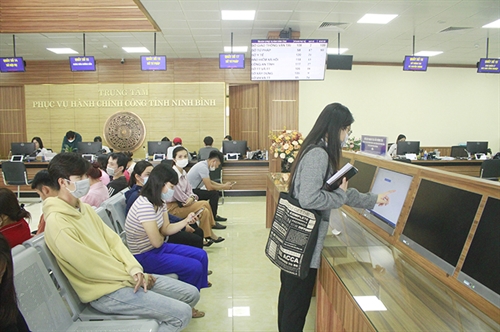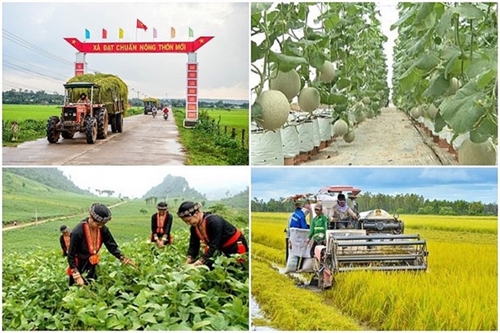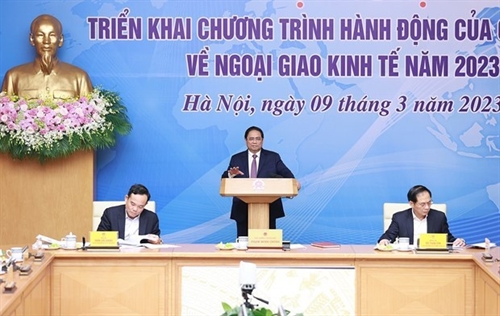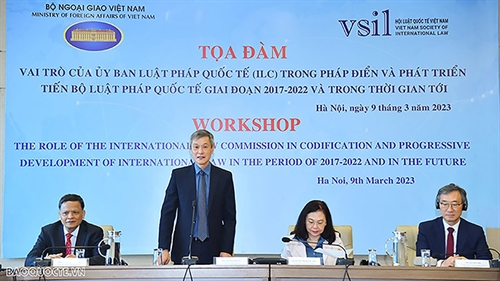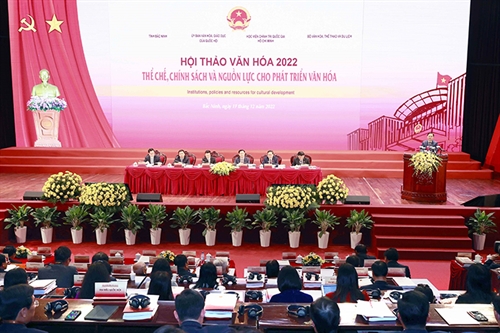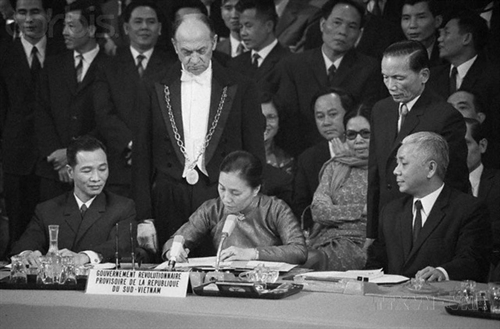Center for Community Support and Development Studies, Center for Research and
Training of the Vietnam Fatherland Front, and United Nations Development Program
Introduction
Headlined by a rebound in citizens’ economic optimism that contrasts with still visible scarring from the COVID-19 pandemic, the 2022 Provincial Governance and Public Administration Performance Index (PAPI) Report,[1] released on April 12, also provides an important temperate check on government performance two years into its term and reveals changing public sentiment in the fight against corruption amid high expectations of effective governance that meets people’s evolving aspirations.
This article is an excerpt from the 2022 PAPI Report and presents key findings from the 2022 PAPI citizen surveys regarding issues of citizens’ greatest concern and citizens’ assessment of governance and public administration performance at the national level in 2022. The Report records the voices of 16,117 respondents from across Vietnam, who shared their experiences of local government performance in governance, public administration and public service delivery during 2022. These respondents were randomly selected to represent the views of a broad spectrum of Vietnamese citizens, aged 18 years and above, from various demographic backgrounds. Of the 2022 PAPI survey sample, 14,931 were permanent residents from across Vietnam’s 63 provinces, and 1,186 were temporary residents from 12 provinces with the highest net ratios of internal migrants as reported in Vietnam’s 2019 Census data.
With PAPI now covering a third government term from 2021 to 2026 (after the 2011-16 and 2016-21 terms), its time-series datasets serve as a treasure trove of data and information that is useful for policy research and advocacy. PAPI data help anticipate governance trends and facilitate solutions to improve government functioning and performance, so that citizens feel more confident in government and motivated to contribute to Vietnam’s sustainable development, especially its recovery efforts after the pandemic-stricken year of 2021 and amidst economic uncertainties.
Issues of greatest concern for citizens in 2022 and the COVID-19 recovery
Each year, the PAPI survey asks citizens to assess the issue of greatest concern they think the central government should prioritize in the coming year. As with their assessment of household and national economic conditions, further evidence of the COVID-19 recovery is also visible in citizens’ selection of key issues of concern.
The transition to the post-pandemic era is also reflected in health/health insurance as the 2021’s issue of greatest concern. Following the dramatic spike in health/health insurance as the most pressing national issue in 2021, it plummeted in 2022 (from 23.84 percent to 4.86 percent) to be overtaken by poverty/hunger (22.13 percent) - perennially at the top of the list since 2015, aside from pandemic-hit 2021 (see Figure 1).
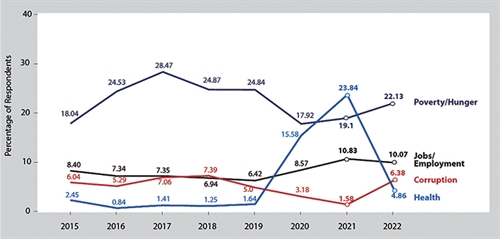 |
Figure 1: Changes in selected issues of greatest concern, 2015-22
While this dramatic change could be expected with the decreasing profile of COVID-19 as a defining governance issue, there were other notable takeaways from the 2022’s results.
Despite the high-profile national anti-corruption campaign, citizens expressed a greater level of concern with corruption in 2022 from a year earlier, with a 4.8 percent rise. This trend is consistent with PAPI’s findings in Dimension 4 ‘Control of Corruption in the Public Sector’, which saw the first publicly perceived downturn in government performance in tackling of corruption since 2015. One of the factors driving the declining numbers in this dimension was increased concern about nepotism in state employment, with land registration being another area where citizens identified particularly high levels of opacity and corruption.
The quality of roads saw the second largest jump from 2021 (3.68 percent), to rank as the fourth most important issue in 2022, with economic growth/GDP second on the list and followed by jobs/employment.
Interestingly, citizens believe different levels of government should take the lead in addressing these wide-ranging issues of concern. The findings point to citizens viewing the central government as best placed to address economic issues and root out corruption. With corruption moving to the fore in PAPI 2022 as a hot button issue of concern, also in the context of the national crack-down, this does not mean that authorities at provincial or local levels are absolved from tackling this pervasive threat. Instead, Vietnamese respondents consider the central government the most appropriate institution to deal with it.
Turning to other levels of authority, road quality and land were key issues respondents associated with the provincial level, while at the village level local leaders were seen as more effective in dealing with practical demands, such as law and order.
National overview of governance and public administration performance in 2022
This section presents overall national performance in governance and public administration in 2022 from citizens’ perspective. It first provides a snapshot of how local governments overall performed in eight different dimensions: (i) Participation at Local Levels, (ii) Transparency in Local Decision-making, (iii) Vertical Accountability Toward Citizens, (iv) Control of Corruption in the Public Sector, (v) Public Administrative Procedures, (vi) Public Service Delivery (vii) Environmental Governance, and (viii) E-Governance. It then zooms in some findings relating to Participation at Local Levels, Transparency in Local Decision-making and Control of Corruption in the Public Sector, since these are important for national policy discussion as well as policy implementation in reality.
The year 2022 witnessed a mixed picture of overall performance of governance and public administration in Vietnam.
Taking a broad overview of all eight PAPI dimensional scores, 2022 was a mixed year as illustrated in Figure 2. While three dimensions of Participation at Local Levels (Dimension 1), Public Administrative Procedures (Dimension 5) and E-Governance (Dimension 8) showed progress, Dimension 2 ‘Transparency in Local Decision-making’ remained largely unchanged. However, the other four dimensions saw declines, with the drop-off in performance in Control of Corruption in the Public Sector (Dimension 4) and Public Service Delivery (Dimension 6) particularly significant.
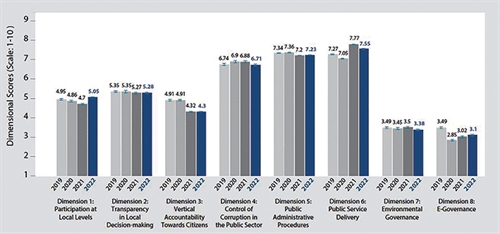 |
Figure 2: Overall PAPI dimensional score changes over time, 2019-22
Little progress was made in ensuring transparency in local decision-making in the areas PAPI measures, especially in land planning and pricing.
In Dimension 2 Transparency in Local Decision-making’, one bright spot was the publicity of commune budgets and expenditure, where more people said they were able to access such financial information. Taken together, however, the developments in Dimension 2 were not all positive. One reason leading to the stagnation of the dimensional score is the decline in transparency in the publicized poverty lists. The key reason for this trend is reductions in the perceived accuracy of the lists of poor households, with 5 percentage points more of respondents reporting that eligible candidates were not on the lists compared to 2021. Another area of concern was people searching for State policies and government regulations were less likely in 2022 to say they found the information they were looking for.
In terms of land transparency, citizens’ limited awareness is also evident in engagement in local land use planning. The PAPI survey also explored how informed citizens were about land use plans that may result in land seizures. Notably, the percentage of respondents who reported having been invited to provide comments on and being informed about local annual land use plans in 2022 remained low at 28.5 percent and 17.7 percent, respectively, a slight 3 percent increase from 2021. One possibility is that citizens were less likely to demand information about land use plans if they were less concerned about the possibility of having land seized. Another possibility is that many local governments did not update and disclose annual local land use plans.
This discourse has now spilled over into ongoing revisions to the 2013 Land Law, the overarching legal document that regulates land transactions, acquisitions, seizures and compensation. To help inform these policy discussions, PAPI in 2022 explored citizens’ perceptions and experiences with local land governance and whether current regulations provide a level playing field.
Set against the national context of property as a driver of economic growth, encroaching urbanization and industrialization eating away at once productive rural land, pressing infrastructure needs and the cultural importance of land to Vietnamese, PAPI in 2022 harvested data to gain insights into land seizure rates, differences between market and official land prices used for compensation, public awareness and engagement in land planning and how citizens acquire land.
The 2022 PAPI findings show that while the level of residential land seizures remains low, a key headline is farmland seizures reportedly increased in 2022. About 4.1 percent of respondents in 2022 disclosed they had farmland seized (see Figure 3). This percentage is far more significant when considering the context of rural populations, for whom this is a high-profile issue, where land is a determinant of livelihoods and prosperity for many households. In villages where at least 30 percent of residents work in agriculture, 6.5 percent reported having farmland seized in 2022 - up from 5.4 percent in 2021. While reported land seizure rates declined dramatically until 2022 since the most recent revision of the Land Law in 2013, seizures of farmland in rural areas remain a salient issue which should be addressed by stronger regulations in the Land Law regarding transparency and equal access to land information. This contrasts with more low-profile residential land seizures at 1.4 and 1.67 percent in 2021 and 2022, respectively.
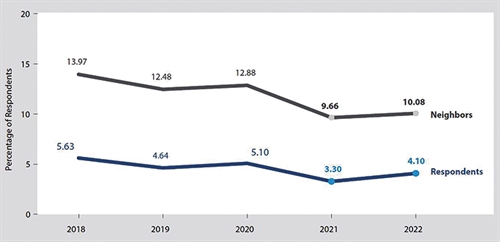 |
Figure 3: Percentage of respondents having their farmland seized, 2018-22
A common source of friction underpinning the land seizure process is the perceived low levels of compensation offered by authorities to citizens. To explore reasons for this apparent disconnect, PAPI in 2022 set out to discover citizens’ knowledge of market and official land use rights prices and how they influence perceptions of compensation.
To achieve this, PAPI conducted a unique experiment by asking each half of survey respondents about the official market price and market rate for a square meter of land in their locality. The results, as presented in Figure 4, underlined a distinct divergence in prices. In rural areas, there was little difference. However, in urban areas where land prices are higher, there were substantial differences: The average estimated market price for a square meter of land was VND 57.7 million compared to an average estimated official price of VND 42.2 million - a difference of VND 15.5 million. This suggests that local governments are perceived to not take into account market rates when setting land seizure compensation.
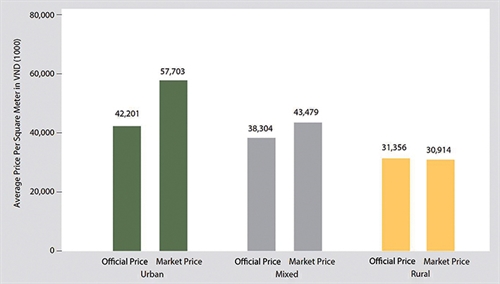 |
Figure 4: Difference between official and market land price, 2022
Drilling deeper, PAPI’s survey points to citizens’ low awareness of land prices in general, with up to 70 percent of respondents unable to estimate a market or official land price. This knowledge gap is compounded by the finding that many people were only aware of the official land price when personally impacted by a land seizure. These findings have policy implications, with the necessity for more frequent changes in official prices, rather than every four years, to keep up with rapidly changing market prices – particularly in urban areas.
Tackling corruption in the public sector at the local level took a step back from 2021.
Echoing citizens’ one of top five issues of greatest concern being corruption, as shown in Figure 5, scores fell in 2022 across all four sub-dimensions of Dimension 4 ‘Control of Corruption in the Public Sector’: Limits on Corruption in Local Government, Limits on Corruption in Public Services, Equity in State Employment, and Government Willingness to Fight Corruption.
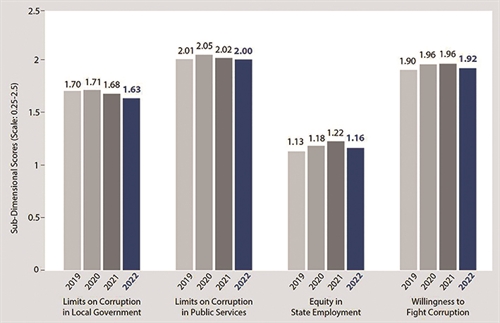 |
Figure 5: Changes in Control of Corruption in the Public SectorSub-Dimensions, 2019-22
One of the factors driving the declining numbers was increased concern about nepotism in state employment, making the sub-dimension “Equity in State Employment” score drop. Looking deeper into the survey findings,[2] across a range of positions, citizens thought connections were more important to get hired in each of these positions in 2022 compared to 2021. This figure shows some interesting variations in the degree to which connections are required across different positions. In particular, some of the highest levels of concern about nepotism are focused on land registration officers. Overall, the trends are concerning. Each year since the anti-corruption campaign began in 2016 up to 2021, PAPI survey results from Dimension 4 ‘Control of Corruption in the Public Sector’ showed positive trends. The 2022 survey for the first time in six years showed a reversal in this trend.
As to whether citizens felt the government was committed to tackling corruption, the survey showed they have more faith in the central government to address it than at local level. As shown in Figure 6, while a total of 62.8 percent of respondents said that corruption decreased at the national level in 2021, that percentage fell to 60.67 percent in 2022. Similar reversals occurred when respondents were asked about changes in corruption situations at the provincial level.
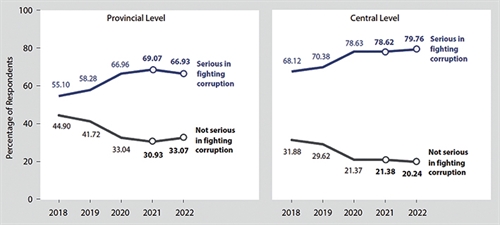 |
Figure 6: Government officials serious in fighting corruption
Implications and key takeaways
Overall, this article has revealed some worrying trends in 2022 based on citizens’ perspectives. The headline message is the downward trend in government performance in Control of Corruption in the Public Sector for the first time since 2016. In terms of government effectiveness in Transparency in Local Decision-making, the article shows some concerning changes in the accuracy of poverty lists and access to information about official laws and regulations as well as land transparency.
Turning to the issues of greatest concern based on citizens’ perspectives, this article revealed worrying trends within the dimension of Control of Corruption in the Public Sector, with citizens in open-ended questions more likely to cite corruption as an overarching issue that requires intensive State action. In contrast, concerns about health care and health insurance - the top issue in 2021, eased in 2022 to reflect the decreasing profile of COVID-19 as a defining governance issue.
Importantly for governance, this article also underlined that citizens have strikingly different expectations for the central government compared to provincial, district and grassroots levels. While citizens want the central government to address economic issues, they largely look to the lower levels of government for infrastructure and public service delivery. Road quality and land, in particular, are key issues that respondents associate with the provincial level. This suggests that citizens’ concerns and expectations require relevant levels of government to respond timely.
The overall aim of PAPI is to improve the quality of government functions, responsiveness, transparency, and accountability of public institutions, and ensure basic human rights in terms of freedom of expression, access to information and access to quality services. With evidence collected from citizens as the end-users of government services, not only through PAPI surveys but also thematic research and policy advice, PAPI helps identify policy gaps that can inform policy-making agencies and motivate improvement in government performance. The following key-takeaways may be useful for Vietnamese policymakers and practitioners:
Enhancing transparency in local decision-making
Attention and action are needed to improve accuracy in poor household listing and enhancing transparency of land use plans and of land pricing.Local governments, especially at provincial and district levels, are responsible for collecting public comments and publicly posting annual land use plans. It is essential to grab the opportunity presented by the planned revision of the Land Law to include mechanisms that closely monitor and address non-compliance with requirements for disclosing and making land information transparent, especially with respect to participatory land governance.Improving control of corruption in the public sector
Anti-corruption efforts should continue at the local level, not just at the national level.Addressing nepotism for jobs in the state apparatus should start at the commune level.Developing e-governance is considered one measure to increase transparency and reduce corruption.-
[1] The Vietnam Provincial Governance and Public Administration Performance Index (PAPI) is a policy monitoring tool that assesses citizen experiences and satisfaction with government performance at the national and sub-national levels in governance, public administration and public service delivery. Following the initial pilot in 2009 and a larger survey in 2010, the PAPI survey has been implemented nationwide each year since 2011. In total, 178,243 Vietnamese citizens nationwide have been directly interviewed for PAPI since 2009. PAPI measures eight dimensions: Participation at Local Levels, Transparency in Local Decision-making, Vertical Accountability Toward Citizens, Control of Corruption in the Public Sector, Public Administrative Procedures, Public Service Delivery, Environmental Governance, and E-Governance. PAPI is the result of collaboration between the Center for Community Support and Development Studies (CECODES), the Center for Research and Training of the Vietnam Fatherland Front (VFF-CRT), Real-Time Analytics and the United Nations Development Program (UNDP). For more information about the PAPI research and reports, visit www.papi.org.vn. [2] See the 2022 PAPI Report at: https://papi.org.vn/eng/bao-cao/, p. 14.

